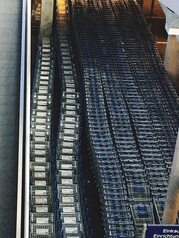Connectivity and Opportunities: Increase the Value of Your Home

Connectivity is a key factor that can radically transform the value of your home. In an increasingly interconnected world, location and the opportunities it offers are crucial for increasing its appreciation. From access to public services to proximity to educational and commercial centers, every aspect matters. Discover how to enhance your real estate investment by leveraging the advantages of good connectivity and become an informed owner who knows how to maximize the value of their property.
The Importance of Connectivity in the Real Estate Market
Connectivity has become a fundamental pillar in the modern real estate market. Buyers and renters seek not only a home but also a lifestyle that allows them easy access to a variety of services and activities. Proximity to efficient public transportation, well-maintained road networks, and sustainable mobility options are elements that significantly enhance the appeal of a property. This interconnected environment not only benefits the quality of life of residents but also boosts the value of the property before potential buyers or tenants.
Additionally, connectivity goes beyond transportation; it includes aspects such as the availability of high-speed internet, which has become essential for those working from home or requiring constant access to digital resources. Well-connected areas tend to house a greater number of services, such as schools, hospitals, and recreational spaces, making them preferred options for young families and professionals. Therefore, investing in properties located in areas with good connectivity not only ensures comfort for current residents but also guarantees ongoing appreciation of the property's value in the long term.
2. How Technology Increases the Value of Your Home
Technology has revolutionized the way we live and, therefore, how we value our properties. The incorporation of smart devices, such as connected thermostats, automated security systems, and voice assistants, not only enhances the comfort and energy efficiency of the home but also makes it more appealing to potential buyers. These technological advancements allow for more precise control over the home environment, offering a personalized experience that aligns with the expectations of modern buyers. In this sense, a home equipped with advanced technology can stand out significantly in the real estate market.
In addition to improving the quality of life of its inhabitants, technology also directly impacts the economic value of the property. Homes with integrated systems that promote sustainability—such as solar panels or energy-efficient appliances—are increasingly in demand and can reach higher prices compared to similar properties without these features. By investing in technological and sustainable upgrades, homeowners not only enhance the aesthetic and functional appeal of their home but also boost their long-term investment by aligning with current trends in the real estate market.
3. Strategies to Evaluate Connectivity in Your Area
To assess connectivity in your area, it is essential to start by researching the availability of services such as high-speed internet and mobile phone service. These elements are crucial for remote work, online study, and entertainment, which can significantly influence the decision to buy or rent a home. You can use online tools that allow you to check the coverage of different providers and compare speeds. Additionally, consider the opinions of current residents about their experience with these services, as this will give you a clearer insight into the quality of connectivity in your neighborhood.
Another important aspect to consider is accessibility to public transportation and main roads. Proximity to metro stations, bus stops, or transit points can facilitate daily commutes to key places like workplaces or educational institutions. Take a tour of your area to observe the available routes and their frequency, as well as traffic conditions during different times. This not only affects your daily quality of life but can also be an attractive feature for future buyers or renters interested in living in a well-connected area that offers convenience and time savings.
4. Urban Projects and Their Impact on Value Increase
Urban projects are essential drivers of development and growth in any city. The implementation of new infrastructure, such as roads, public transportation, and recreational spaces, not only improves the quality of life for residents but also acts as a catalyst for increasing the value of nearby properties. When an area benefits from careful urban planning that includes parks, community centers, and access to major routes, it becomes an attractive place for potential buyers and tenants. This means that investing in a property in an area where these projects are underway can result in a significant increase in long-term value.
Additionally, public perception of a location can change drastically with the execution of urban projects. For example, the construction of a new shopping center or the improvement of public transportation can transform a previously undervalued area into a hotspot for investors and families. Visible improvements not only make the area more desirable but also encourage local economic development by attracting additional businesses and services. In this sense, property owners should keep an eye on announcements about future urban projects in their surroundings and consider how these may positively influence their real estate investment. The key is to identify those opportunities before the market reacts and adjusts prices upward.
5. Public Transport: A Key Factor in Real Estate Valuation
Public transportation is an essential component in the valuation of a property, as its proximity can determine the comfort and quality of life of residents. Areas well connected through buses, trains, or the metro tend to attract a greater number of potential buyers, especially those looking to avoid traffic and parking complications. Accessibility to public transportation not only facilitates daily commuting to work or school but also opens up a range of recreational and social opportunities by allowing easy access to various points of interest in the city. Therefore, properties located near these infrastructures usually have higher demand and, consequently, greater appreciation.
Additionally, investment in public transport infrastructure is often an indicator of the future development of an area. When new lines or improvements to existing services are announced, it is common to see an immediate increase in interest in nearby properties. This is because future residents value not only the current convenience but also the potential growth of the area. In this sense, keeping an eye on urban planning and government investments related to public transport can provide clues about how real estate values in your neighborhood might evolve. Thus, those owners who are informed and prepared to act in response to these changes can benefit significantly when selling or renting their properties.
6. The Benefits of Remote Work in Connected Areas
Remote work has become a trend that redefines the way we live and work, especially in connected areas. The possibility of working from home not only expands job opportunities for residents but also attracts professionals from various regions seeking a balance between quality of life and access to employment. This generates an increase in the demand for properties in well-connected areas, thereby raising their value. Additionally, by offering a conducive environment for telecommuting, these areas become attractive destinations for young families and digital nomads, fostering a vibrant and diverse community.
Another benefit of remote work is the ability of individuals to choose to live away from congested urban centers without sacrificing their professional careers. Areas connected with good technological infrastructure allow workers to enjoy larger and quieter spaces while remaining integrated into the global labor market. This new dynamic not only improves the quality of life for residents but also contributes to local economic development. Thus, by investing in properties located in areas where remote work thrives, owners can benefit not only from the increase in real estate value but also from the cultural and social growth that occurs when new talents settle in the region.
7. Emerging Areas: Investment Opportunities through Connectivity
Emerging areas have become a focal point for investors looking to maximize the value of their properties. These areas, often less developed but with significant growth potential, are being driven by improvements in connectivity. Infrastructure projects such as new roads, public transport lines, and access to high-speed internet are transforming these regions. As a result, housing demand begins to rise, leading to an appreciation in real estate value. Investing in these areas can offer unique opportunities for those seeking to achieve an attractive return on their investment.
Additionally, connectivity not only refers to physical transport; it also encompasses access to digital services and community connections that are essential in modern life. Emerging areas with good digital connectivity tend to attract young professionals and families who value working from home or enjoying accessible recreational activities. This type of demographic contributes to local economic development and can further drive property prices up. Thus, those who invest in areas with good connectivity prospects may benefit from both the increase in property value and the overall appeal of the area to future buyers or tenants.
8. Tips to Improve Your Home Connectivity
To improve the connectivity of your home, it is essential to evaluate and optimize the internet and telephone services available in your area. Make sure to have a provider that offers a fast and stable connection, as a good internet signal is not only essential for remote work but also increases the appeal of the home for future buyers or tenants. Consider installing additional technology such as signal repeaters or state-of-the-art routers that can extend Wi-Fi coverage throughout your property, ensuring that every corner is well connected.
In addition to the internet, other physical aspects can influence the perception of connectivity. The implementation of smart home systems can be a major attraction; for example, voice-controlled lights, programmable thermostats, and security cameras connected to mobile apps are features increasingly valued by buyers. It is also advisable to promote an accessible environment by improving nearby public transportation or creating bike lanes and pedestrian pathways that facilitate access to key places such as schools and shops. These elements not only enhance your daily quality of life but also significantly increase the perceived value of your property in the real estate market.



